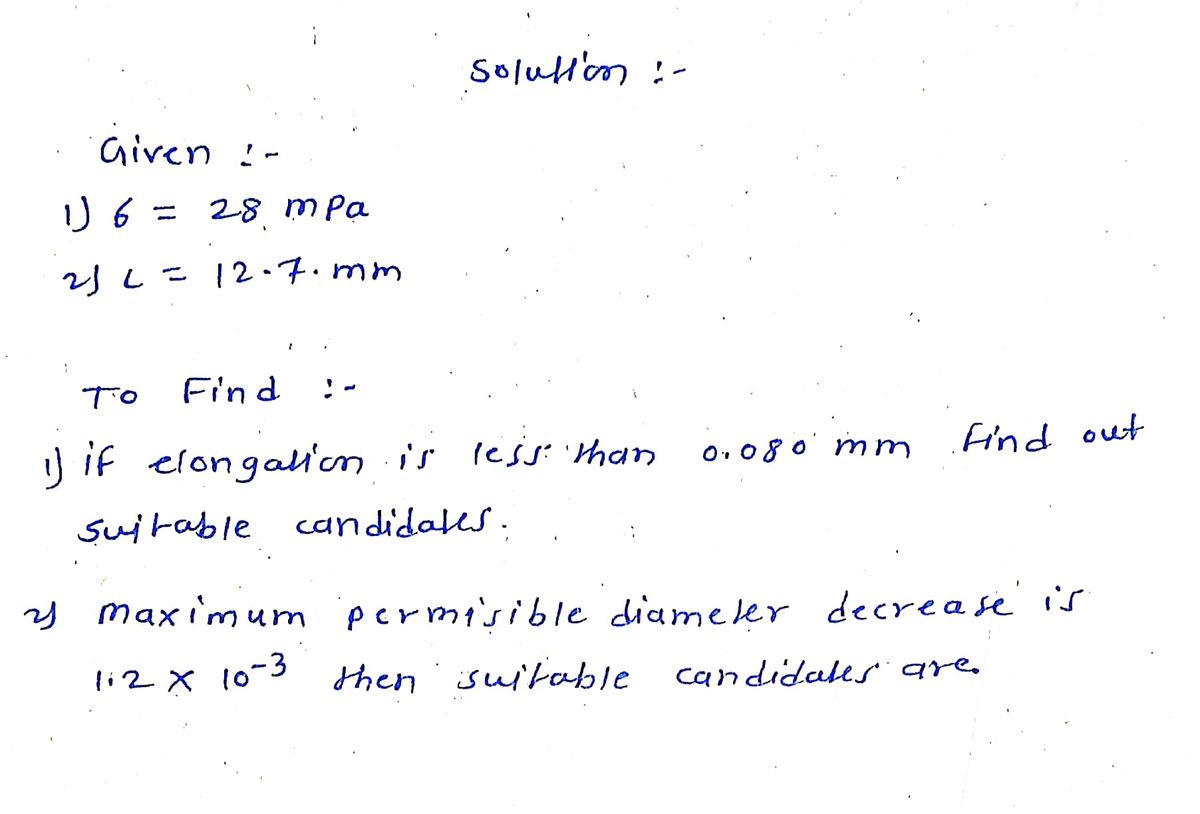A cylindrical metal specimen 12.7 mm (0.5 in.) in diameter and 250 mm (10 in.) long is to be subjected to a tensile stress of 28 MPa (4000 psi); at this stress level, the resulting deformation will be totally elastic. (a) If the elongation must be less than 0.080 mm (3.2 × 10-3 in.), which of the metals in Table 6.1 are suitable candidates? O Steel O Nickel O Brass O Magnesium O Aluminum О Соррer O Titanium O Tungsten (b) If, in addition, the maximum permissible diameter decrease is 1.2 × 10-³ mm (4.7 × 10-5 in.) when the tensile stress of 28 MPa is applied, which of the metals that satisfy the criterion in part (a) are suitable candidates? O Aluminum O Magnesium O Steel O Tungsten О Соррer O Brass O Titanium O Nickel
A cylindrical metal specimen 12.7 mm (0.5 in.) in diameter and 250 mm (10 in.) long is to be subjected to a tensile stress of 28 MPa (4000 psi); at this stress level, the resulting deformation will be totally elastic. (a) If the elongation must be less than 0.080 mm (3.2 × 10-3 in.), which of the metals in Table 6.1 are suitable candidates? O Steel O Nickel O Brass O Magnesium O Aluminum О Соррer O Titanium O Tungsten (b) If, in addition, the maximum permissible diameter decrease is 1.2 × 10-³ mm (4.7 × 10-5 in.) when the tensile stress of 28 MPa is applied, which of the metals that satisfy the criterion in part (a) are suitable candidates? O Aluminum O Magnesium O Steel O Tungsten О Соррer O Brass O Titanium O Nickel
Materials Science And Engineering Properties
1st Edition
ISBN:9781111988609
Author:Charles Gilmore
Publisher:Charles Gilmore
Chapter6: Introduction To Mechanical Properties
Section: Chapter Questions
Problem 6.2DP
Related questions
Concept explainers
Question

Transcribed Image Text:A cylindrical metal specimen 12.7 mm (0.5 in.) in diameter and 250 mm (10 in.) long is to be subjected to a tensile stress of 28 MPa
(4000 psi); at this stress level, the resulting deformation will be totally elastic.
(a) If the elongation must be less than 0.080 mm (3.2 x 10-3 in.), which of the metals in Table 6.1 are suitable candidates?
O Steel
O Nickel
Brass
O Magnesium
O Aluminum
O Copper
O Titanium
O Tungsten
(b) If, in addition, the maximum permissible diameter decrease is 1.2 x 103 mm (4.7 × 105 in.) when the tensile stress of 28 MPa is
applied, which of the metals that satisfy the criterion in part (a) are suitable candidates?
O Aluminum
O Magnesium
O Steel
O Tungsten
O Copper
O Brass
O Titanium
O Nickel
Expert Solution
Step 1

Trending now
This is a popular solution!
Step by step
Solved in 3 steps with 3 images

Knowledge Booster
Learn more about
Need a deep-dive on the concept behind this application? Look no further. Learn more about this topic, civil-engineering and related others by exploring similar questions and additional content below.Recommended textbooks for you

Materials Science And Engineering Properties
Civil Engineering
ISBN:
9781111988609
Author:
Charles Gilmore
Publisher:
Cengage Learning

Materials Science And Engineering Properties
Civil Engineering
ISBN:
9781111988609
Author:
Charles Gilmore
Publisher:
Cengage Learning